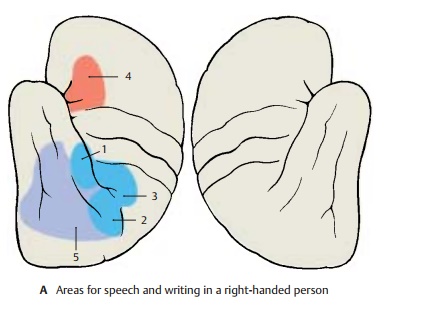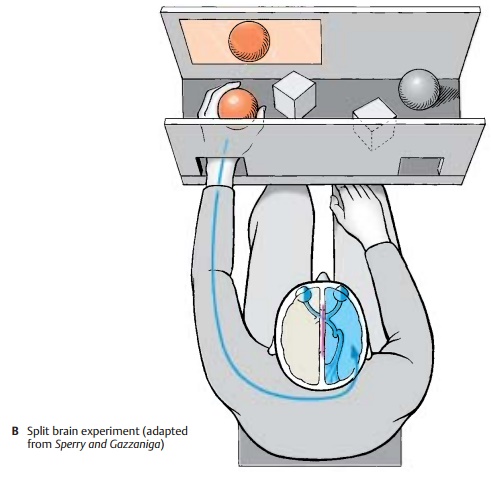Chapter: Human Nervous System and Sensory Organs : Telencephalon
Neocortex: Hemispheric Asymmetry
Hemispheric Asymmetry
Consciousness is dependent on the cerebralcortex.
Only those sensory stimuli reach consciousness that are transmitted to the
cerebral cortex.
The
faculty of speech is unique to humans. Internal speech is the prerequisite for
thought, just as the spoken word is the basis for communication and writing is
the infor-mation transmitted over thousands of years. In the individual person,
speech de-pends on the integrity of specific cortical areas that usually lie
only in one hemi-sphere. This hemisphere is called the domi-nant hemisphere and is normally the left onein right-handed
persons. In left-handed persons, it may be the right or the left hemi-sphere,
or the faculty may be represented in both hemispheres. Thus, handedness is not a reliable indication
for dominance of the contralateral hemisphere.

In the posterior region of the superior tem-poral gyrus of the dominant hemisphere lies Wernicke’s speech center (A1). Injury to thisarea results in disturbed word comprehen-sion (receptive aphasia, or sensory aphasia). It is an integration area that is indispensable for the continuous availability of learned word patterns and for the interpretation of heard or spoken words. Patients with sensory aphasia utter a senseless word salad (schizophasia), and the speech of other persons sounds to them like an incompre-hensible foreign language. Injury to the angular gyrus (A2), which borders on the su-pramarginal gyrus (A3) (see p. 212, A21), re-sults in the loss of the abilities to write (agraphia) and to read (alexia). Stimulation of adjacent areas (A5), especially of the middle temporal gyrus, causes disturbance in spontaneous speech or writing. Broca ’s area for motor speech coordination (A4) lies in the inferior frontal gyrus.
Injury
to the right (nondominant) hemi-sphere may cause disturbance of the visual and
spatial orientation or the appreciation of music (amusia). Although speech is pre-served, the melody of the language
and the emotional timbre of speech are affectedDifferent ways of thinking have
often been assigned to one of the two hemispheres: the left, dominant
hemisphere is thought to work in a logical, rational, and analytical way, while
the right hemisphere is sup-posed to be integrative, synthetic, and intui-tive.
These generalizations are largely speculative.
Transection of the corpus callosum (splitbrain). There are no changes in personality
or intelligence following the transection of the corpus callosum. The patients
are completely normal in everyday life. Only special tests of the tactile and
visual systems will reveal any shortcomings (B).

Touch
sensation of the left hand is regis-tered in the right hemisphere, that of the
right hand in the left hemisphere (in right-handed persons, the dominant
hemisphere controls the ability to speak). Visual stimuli affecting the left
halves of each retina are transmitted to the left hemisphere, while the stimuli
for the right halves are trans-mitted to the right hemisphere. An examination
shows that right-handed per-sons with a severed corpus callosum can only read
with the left halves of the retinas. They cannot name objects perceived with
the right halves of the retina. However, they can illustrate the use of these
objects through movements with their hands. The same phenomenon occurs when
such per-sons have their eyes covered and receive an object in their left hand:
they are unable to describe it verbally but can indicate its use through
gestures. Objects perceived with the right hand, or with the left halves of the
retina which are connected to the “speak-ing” hemisphere, are immediately
named.Movements performed with one limb can-not be repeated with the
contralateral limb, because the one hemisphere has not been informed about the
impulses been sent out by the other hemisphere.
Related Topics